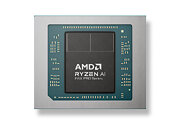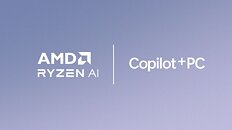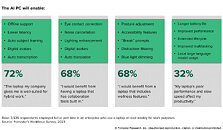T0@st
News Editor
- Joined
- Mar 7, 2023
- Messages
- 2,385 (3.37/day)
- Location
- South East, UK
AI PC capabilities have evolved rapidly in the two years since AMD introduced the first x86 AI PC CPUs at CES 2023. New neural processing units have debuted, pushing available performance from a peak of 10 AI TOPS at the launch of the AMD Ryzen 7 7840U processor to peak 50+ TOPS on the latest AMD Ryzen AI Max PRO 300 Series processors. A wide range of software and hardware companies have announced various AI development plans or brought AI-infused products to market, while major operating system vendors like Microsoft are actively working to integrate AI into the operating system via its Copilot+ PC capabilities. AMD is on the forefront of those efforts and is working closely with Microsoft to deliver Copilot+ for Ryzen AI and Ryzen AI PRO PCs.
In the report "The Year of the AI PC is 2025," Forrester lays out its argument for why this year is likely to bring significant changes for AI PCs. Forrester defines the term "AI PC" to mean any system "embedded with an AI chip and algorithms specifically designed to improve the experience of AI workloads across the computer processing unit (CPU), graphics processing unit (GPU), and neural processing unit (NPU)." This includes AMD products, as well as competing products made by both x86 and non-x86 CPU manufacturers. 2025 represents a turning point for these efforts, both in terms of hardware and software, and this Forrester report is an excellent deep dive into why AI PCs represent the future for enterprise computing.



Why 2025 is the Year of the AI PC
First, and arguably most prosaically, 2025 is the year of the AI PC because CPU designers like AMD are baking dedicated AI processing into new products just as Windows 10 is approaching the formal end of support. While consumers and businesses will have the option to buy extra years of security updates, October 14, 2025 is the end of free support and the likely transition date to Windows 11 for millions of companies worldwide that don't want to pay an increasingly large yearly premium for the privilege of running an older operating system. Many of the Windows 11 commercial PCs purchased in the next 12 months are going to support AI via dedicated NPU hardware and will therefore qualify as AI PCs. According to IDC, 93.9% of commercial PCs will be AI PCs by 2028.
The advantage of this distribution model is that customers and early adopters are not being asked to sacrifice the CPU and GPU efficiency improvements they would otherwise expect from new systems in exchange for AI compatibility. The AI PC platforms AMD launched throughout 2024 and into 2025, including the AMD Ryzen AI PRO 300 Series and the Ryzen AI Max PRO Series feature improvements like new CPU cores based on the "Zen 5" microarchitecture, AMD RDNA 3.5 GPU cores, and AMD PRO Technologies to provide security features, manageability tools, and enterprise-grade stability and reliability. These advances arrived alongside the NPU and its dedicated AI processing capability, ensuring AMD customers continue to benefit from new systems in the legacy non-AI workloads they already use.
Second, AI PCs offer a flexible platform that executes emerging AI workloads across the CPU, GPU, and NPU, depending on where it will run best. It's not hard to see the parallels between NPU development and the GPU-powered 3D revolution that kicked off back in the mid-1990s.

While specialized 3D graphics initially required the use of discrete graphics accelerator cards, this hardware eventually moved on-die and was integrated directly alongside the CPU. This allowed AMD to dramatically improve the performance and capability of the integrated graphics processor, or iGPU, without driving up cost. Many applications now rely on the iGPU for tasks that previously required a discrete card, and graphics capabilities have become an integral part of a CPU's overall value proposition. Adding an NPU to the CPU and steadily increasing its performance is in line with this innovation. Including an NPU gives developers a dedicated platform for running AI workloads, one that's tightly knitted to the CPU and that can be expected to steadily improve over time.
Today, AI PCs can already offload background tasks that would otherwise require CPU or GPU processing time. More advanced use cases are rapidly proliferating. AMD introduced the first x86 AI PCs in 2023. Two years later, the company's CES 2025 exhibition showcased multiple practical demos. This rapid adoption highlights the NPU's potential efficiency and strength as a workload execution environment compared to the more traditional CPU or GPU.
While CES is largely a consumer-focused show, the broad discussion of AI across both consumer and commercial workloads shows the appeal of integrating artificial intelligence across the entire software market. According to its report, Forrester expects AI and AI PCs to take significant strides towards wide deployment over the next 12 months. This will happen thanks to the Windows 11 refresh cycle, wider AI incorporation across the software industry, and because the increased availability of AI PCs will give companies a cost-effective platform for less intense local AI workloads.
What all of this adds up to is an exciting time for enterprise computing. AI PCs have the potential to revolutionize the industry, and AMD offers a complete lineup for all end-user needs that gives companies extensive options to evaluate how they want to engage with that opportunity.
View at TechPowerUp Main Site | Source
In the report "The Year of the AI PC is 2025," Forrester lays out its argument for why this year is likely to bring significant changes for AI PCs. Forrester defines the term "AI PC" to mean any system "embedded with an AI chip and algorithms specifically designed to improve the experience of AI workloads across the computer processing unit (CPU), graphics processing unit (GPU), and neural processing unit (NPU)." This includes AMD products, as well as competing products made by both x86 and non-x86 CPU manufacturers. 2025 represents a turning point for these efforts, both in terms of hardware and software, and this Forrester report is an excellent deep dive into why AI PCs represent the future for enterprise computing.



Why 2025 is the Year of the AI PC
First, and arguably most prosaically, 2025 is the year of the AI PC because CPU designers like AMD are baking dedicated AI processing into new products just as Windows 10 is approaching the formal end of support. While consumers and businesses will have the option to buy extra years of security updates, October 14, 2025 is the end of free support and the likely transition date to Windows 11 for millions of companies worldwide that don't want to pay an increasingly large yearly premium for the privilege of running an older operating system. Many of the Windows 11 commercial PCs purchased in the next 12 months are going to support AI via dedicated NPU hardware and will therefore qualify as AI PCs. According to IDC, 93.9% of commercial PCs will be AI PCs by 2028.
The advantage of this distribution model is that customers and early adopters are not being asked to sacrifice the CPU and GPU efficiency improvements they would otherwise expect from new systems in exchange for AI compatibility. The AI PC platforms AMD launched throughout 2024 and into 2025, including the AMD Ryzen AI PRO 300 Series and the Ryzen AI Max PRO Series feature improvements like new CPU cores based on the "Zen 5" microarchitecture, AMD RDNA 3.5 GPU cores, and AMD PRO Technologies to provide security features, manageability tools, and enterprise-grade stability and reliability. These advances arrived alongside the NPU and its dedicated AI processing capability, ensuring AMD customers continue to benefit from new systems in the legacy non-AI workloads they already use.
Second, AI PCs offer a flexible platform that executes emerging AI workloads across the CPU, GPU, and NPU, depending on where it will run best. It's not hard to see the parallels between NPU development and the GPU-powered 3D revolution that kicked off back in the mid-1990s.

While specialized 3D graphics initially required the use of discrete graphics accelerator cards, this hardware eventually moved on-die and was integrated directly alongside the CPU. This allowed AMD to dramatically improve the performance and capability of the integrated graphics processor, or iGPU, without driving up cost. Many applications now rely on the iGPU for tasks that previously required a discrete card, and graphics capabilities have become an integral part of a CPU's overall value proposition. Adding an NPU to the CPU and steadily increasing its performance is in line with this innovation. Including an NPU gives developers a dedicated platform for running AI workloads, one that's tightly knitted to the CPU and that can be expected to steadily improve over time.
Today, AI PCs can already offload background tasks that would otherwise require CPU or GPU processing time. More advanced use cases are rapidly proliferating. AMD introduced the first x86 AI PCs in 2023. Two years later, the company's CES 2025 exhibition showcased multiple practical demos. This rapid adoption highlights the NPU's potential efficiency and strength as a workload execution environment compared to the more traditional CPU or GPU.
While CES is largely a consumer-focused show, the broad discussion of AI across both consumer and commercial workloads shows the appeal of integrating artificial intelligence across the entire software market. According to its report, Forrester expects AI and AI PCs to take significant strides towards wide deployment over the next 12 months. This will happen thanks to the Windows 11 refresh cycle, wider AI incorporation across the software industry, and because the increased availability of AI PCs will give companies a cost-effective platform for less intense local AI workloads.
What all of this adds up to is an exciting time for enterprise computing. AI PCs have the potential to revolutionize the industry, and AMD offers a complete lineup for all end-user needs that gives companies extensive options to evaluate how they want to engage with that opportunity.
View at TechPowerUp Main Site | Source







